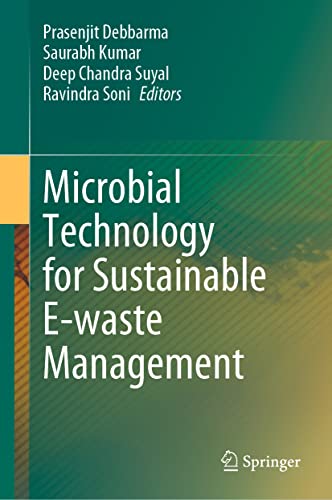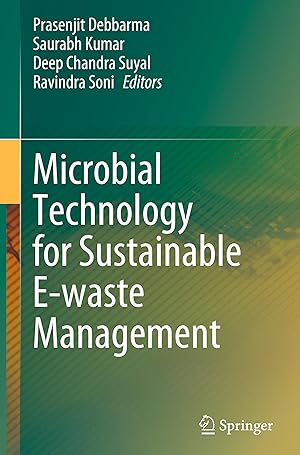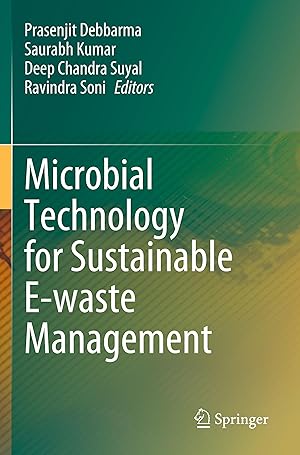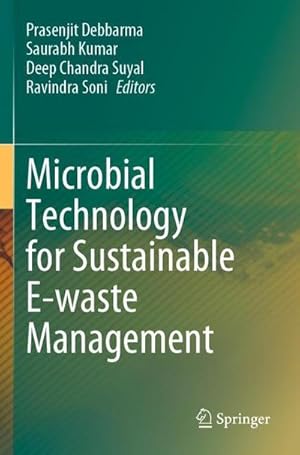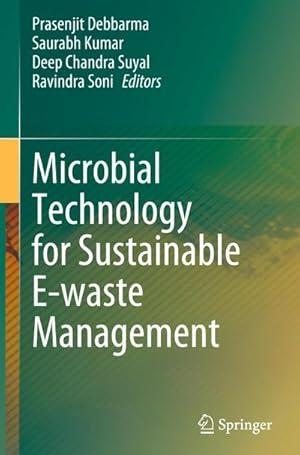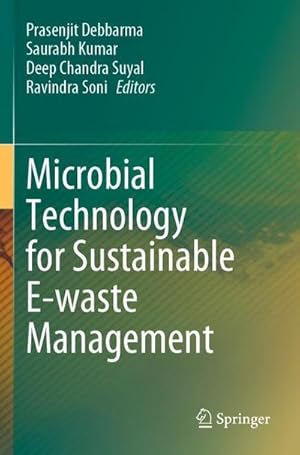debbarma prasenjit kumar saurabh suyal (20 Ergebnisse)
Suchfilter
Produktart
- Alle Product Types
- Bücher (20)
- Magazine & Zeitschriften (Keine weiteren Ergebnisse entsprechen dieser Verfeinerung)
- Comics (Keine weiteren Ergebnisse entsprechen dieser Verfeinerung)
- Noten (Keine weiteren Ergebnisse entsprechen dieser Verfeinerung)
- Kunst, Grafik & Poster (Keine weiteren Ergebnisse entsprechen dieser Verfeinerung)
- Fotografien (Keine weiteren Ergebnisse entsprechen dieser Verfeinerung)
- Karten (Keine weiteren Ergebnisse entsprechen dieser Verfeinerung)
- Manuskripte & Papierantiquitäten (Keine weiteren Ergebnisse entsprechen dieser Verfeinerung)
Zustand Mehr dazu
- Neu (19)
- Wie Neu, Sehr Gut oder Gut Bis Sehr Gut (Keine weiteren Ergebnisse entsprechen dieser Verfeinerung)
- Gut oder Befriedigend (Keine weiteren Ergebnisse entsprechen dieser Verfeinerung)
- Ausreichend oder Schlecht (Keine weiteren Ergebnisse entsprechen dieser Verfeinerung)
- Wie beschrieben (1)
Einband
Weitere Eigenschaften
- Erstausgabe (Keine weiteren Ergebnisse entsprechen dieser Verfeinerung)
- Signiert (Keine weiteren Ergebnisse entsprechen dieser Verfeinerung)
- Schutzumschlag (Keine weiteren Ergebnisse entsprechen dieser Verfeinerung)
- Angebotsfoto (9)
- Keine Print-on-Demand Angebote (13)
Sprache (1)
Preis
- Beliebiger Preis
- Weniger als EUR 20 (Keine weiteren Ergebnisse entsprechen dieser Verfeinerung)
- EUR 20 bis EUR 45 (Keine weiteren Ergebnisse entsprechen dieser Verfeinerung)
- Mehr als EUR 45
Gratisversand
Land des Verkäufers
Verkäuferbewertung
-
Microbial Technology for Sustainable E-waste Management
Anbieter: Ria Christie Collections, Uxbridge, Vereinigtes Königreich
EUR 53,33
EUR 13,60 für den Versand von Vereinigtes Königreich nach USAAnzahl: Mehr als 20 verfügbar
In den WarenkorbZustand: New. In.
-
Microbial Technology for Sustainable E-waste Management
Anbieter: Basi6 International, Irving, TX, USA
Zustand: Brand New. New. US edition. Expediting shipping for all USA and Europe orders excluding PO Box. Excellent Customer Service.
-
Brand new book. Fast ship. Please provide full street address as we are not able to ship to P O box address.
-
Microbial Technology for Sustainable E-waste Management
Verlag: Springer, Berlin|Springer International Publishing|Springer, 2023
ISBN 10: 3031256778 ISBN 13: 9783031256776
Sprache: Englisch
Anbieter: moluna, Greven, Deutschland
EUR 144,94
EUR 48,99 für den Versand von Deutschland nach USAAnzahl: Mehr als 20 verfügbar
In den WarenkorbGebunden. Zustand: New.
-
Microbial Technology for Sustainable E-waste Management
Verlag: Springer, Berlin|Springer International Publishing|Springer, 2024
ISBN 10: 3031256808 ISBN 13: 9783031256806
Sprache: Englisch
Anbieter: moluna, Greven, Deutschland
EUR 144,94
EUR 48,99 für den Versand von Deutschland nach USAAnzahl: Mehr als 20 verfügbar
In den WarenkorbZustand: New.
-
Microbial Technology for Sustainable E-waste Management (Hardcover)
Verlag: Springer International Publishing AG, Cham, 2023
ISBN 10: 3031256778 ISBN 13: 9783031256776
Sprache: Englisch
Anbieter: Grand Eagle Retail, Bensenville, IL, USA
Hardcover. Zustand: new. Hardcover. This book, besides discussing challenges and opportunities, will reveal the microbe-metal interactions and strategies for e-waste remediation in different ecosystems. It will unveil the recent biotechnological advancement and microbiological approach to sustainable biorecycling of e-waste such as bioleaching for heavy metal extraction, valorization of precious metal, biodegradation of e-plastic, the role of the diverse microbial community in e-waste remediation, genetically engineered microbes for e-waste management, the importance of microbial exopolysaccharides in metal biosorption, next-generation technologies, omics-based technologies etc. It also holds the promise to discuss the conservation, utilization and cataloging indigenous microbes in e-waste-polluted niches and promising hybrid technology for sustainable e-waste management.Revolution in the area of information technology and communication is constantly evolving due to scientific research and development.Concurrently, the production of new electrical and electronic equipment also thus uplifting in this era of revolution. These technological advancements certainly have problematic consequences which is the rise of huge amounts of electronic obsoletes or electronic waste (e-waste). Improper management of both hazardous and nonhazardous substances of e-waste led to a major concern in our digital society and environment. Therefore, a sustainable approach including microbial candidates to tackle e-waste is the need of the hour.Nevertheless, the continuous demand for new-generation gadgets and electronics set this high-tech evolution to a new frontier in the last few years. With this continuing trend of technological development, e-waste is expanding exponentially worldwide. In the year of 2019, the worldwide generation of e-waste was approximately 53.6 Mt, of which only about 17.4% of e-waste was collected and recycled, and the other 82.6% was not even documented. E-waste containsvarious heterogeneous waste complexes such as metals (60%), blends of many polymers (30%) and halogenated compounds, radioactive elements and other pollutants (10%), respectively. The sustainable, efficient, and economic management of e-waste is thus, a challenging task today and in the coming decades. Conventional techniques such as the use of chemicals, incineration and informal ways of e-waste dismantling trigger serious health risks and contamination to the human population and environment, respectively due to the liberation of toxic and hazardous substances from the waste. In this context, bio-candidates especially microorganisms could be sharp-edged biological recycling tools to manage e-waste sustainably. As microbes are omnipresent and diverse in their physiology and functional aspects, they offer a wide range of bioremediation. Shipping may be from multiple locations in the US or from the UK, depending on stock availability.
-
Microbial Technology for Sustainable E-waste Management
Verlag: Springer International Publishing, 2023
ISBN 10: 3031256778 ISBN 13: 9783031256776
Sprache: Englisch
Anbieter: Buchpark, Trebbin, Deutschland
Zustand: Hervorragend. Zustand: Hervorragend | Sprache: Englisch | Produktart: Bücher.
-
Zustand: New. 2023rd edition NO-PA16APR2015-KAP.
-
Taschenbuch. Zustand: Neu. Microbial Technology for Sustainable E-waste Management | Prasenjit Debbarma (u. a.) | Taschenbuch | ix | Englisch | 2024 | Springer | EAN 9783031256806 | Verantwortliche Person für die EU: Springer Verlag GmbH, Tiergartenstr. 17, 69121 Heidelberg, juergen[dot]hartmann[at]springer[dot]com | Anbieter: preigu.
-
Microbial Technology for Sustainable E-waste Management
Verlag: Springer International Publishing, Springer Nature Switzerland Mär 2023, 2023
ISBN 10: 3031256778 ISBN 13: 9783031256776
Sprache: Englisch
Anbieter: buchversandmimpf2000, Emtmannsberg, BAYE, Deutschland
Buch. Zustand: Neu. Neuware -This book, besides discussing challenges and opportunities, will reveal the microbe-metal interactions and strategies for e-waste remediation in different ecosystems. It will unveil the recent biotechnological advancement and microbiological approach to sustainable biorecycling of e-waste such as bioleaching for heavy metal extraction, valorization of precious metal, biodegradation of e-plastic, the role of the diverse microbial community in e-waste remediation, genetically engineered microbes for e-waste management, the importance of microbial exopolysaccharides in metal biosorption, next-generation technologies, omics-based technologies etc. It also holds the promise to discuss the conservation, utilization and cataloging indigenous microbes in e-waste-polluted niches and promising hybrid technology for sustainable e-waste management.Revolution in the area of information technology and communication is constantly evolving due to scientific research and development.Concurrently, the production of new electrical and electronic equipment also thus uplifting in this era of revolution. These technological advancements certainly have problematic consequences which is the rise of huge amounts of electronic obsoletes or electronic waste (e-waste). Improper management of both hazardous and nonhazardous substances of e-waste led to a major concern in our digital society and environment. Therefore, a sustainable approach including microbial candidates to tackle e-waste is the need of the hour.Nevertheless, the continuous demand for new-generation gadgets and electronics set this high-tech evolution to a new frontier in the last few years. With this continuing trend of technological development, e-waste is expanding exponentially worldwide. In the year of 2019, the worldwide generation of e-waste was approximately 53.6 Mt, of which only about 17.4% of e-waste was collected and recycled, and the other 82.6% was not even documented. E-waste containsvarious heterogeneous waste complexes such as metals (60%), blends of many polymers (30%) and halogenated compounds, radioactive elements and other pollutants (10%), respectively. The sustainable, efficient, and economic management of e-waste is thus, a challenging task today and in the coming decades. Conventional techniques such as the use of chemicals, incineration and informal ways of e-waste dismantling trigger serious health risks and contamination to the human population and environment, respectively due to the liberation of toxic and hazardous substances from the waste. In this context, bio-candidates especially microorganisms could be sharp-edged biological recycling tools to manage e-waste sustainably. As microbes are omnipresent and diverse in their physiology and functional aspects, they offer a wide range of bioremediation.Springer Verlag GmbH, Tiergartenstr. 17, 69121 Heidelberg 364 pp. Englisch.
-
Microbial Technology for Sustainable E-waste Management
Verlag: Springer International Publishing, 2024
ISBN 10: 3031256808 ISBN 13: 9783031256806
Sprache: Englisch
Anbieter: AHA-BUCH GmbH, Einbeck, Deutschland
Taschenbuch. Zustand: Neu. Druck auf Anfrage Neuware - Printed after ordering - This book, besides discussing challenges and opportunities, will reveal the microbe-metal interactions and strategies for e-waste remediation in different ecosystems. It will unveil the recent biotechnological advancement and microbiological approach to sustainable biorecycling of e-waste such as bioleaching for heavy metal extraction, valorization of precious metal, biodegradation of e-plastic, the role of the diverse microbial community in e-waste remediation, genetically engineered microbes for e-waste management, the importance of microbial exopolysaccharides in metal biosorption, next-generation technologies, omics-based technologies etc. It also holds the promise to discuss the conservation, utilization and cataloging indigenous microbes in e-waste-polluted niches and promising hybrid technology for sustainable e-waste management.Revolution in the area of information technology and communication is constantly evolving due to scientific research and development.Concurrently, the production of new electrical and electronic equipment also thus uplifting in this era of revolution. These technological advancements certainly have problematic consequences which is the rise of huge amounts of electronic obsoletes or electronic waste (e-waste). Improper management of both hazardous and nonhazardous substances of e-waste led to a major concern in our digital society and environment. Therefore, a sustainable approach including microbial candidates to tackle e-waste is the need of the hour.Nevertheless, the continuous demand for new-generation gadgets and electronics set this high-tech evolution to a new frontier in the last few years. With this continuing trend of technological development, e-waste is expanding exponentially worldwide. In the year of 2019, the worldwide generation of e-waste was approximately 53.6 Mt, of which only about 17.4% of e-waste was collected and recycled, and the other 82.6% was not even documented. E-waste containsvarious heterogeneous waste complexes such as metals (60%), blends of many polymers (30%) and halogenated compounds, radioactive elements and other pollutants (10%), respectively. The sustainable, efficient, and economic management of e-waste is thus, a challenging task today and in the coming decades. Conventional techniques such as the use of chemicals, incineration and informal ways of e-waste dismantling trigger serious health risks and contamination to the human population and environment, respectively due to the liberation of toxic and hazardous substances from the waste. In this context, bio-candidates especially microorganisms could be sharp-edged biological recycling tools to manage e-waste sustainably. As microbes are omnipresent and diverse in their physiology and functional aspects, they offer a wide range of bioremediation.
-
Microbial Technology for Sustainable E-waste Management
Verlag: Springer International Publishing, 2023
ISBN 10: 3031256778 ISBN 13: 9783031256776
Sprache: Englisch
Anbieter: AHA-BUCH GmbH, Einbeck, Deutschland
Buch. Zustand: Neu. Druck auf Anfrage Neuware - Printed after ordering - This book, besides discussing challenges and opportunities, will reveal the microbe-metal interactions and strategies for e-waste remediation in different ecosystems. It will unveil the recent biotechnological advancement and microbiological approach to sustainable biorecycling of e-waste such as bioleaching for heavy metal extraction, valorization of precious metal, biodegradation of e-plastic, the role of the diverse microbial community in e-waste remediation, genetically engineered microbes for e-waste management, the importance of microbial exopolysaccharides in metal biosorption, next-generation technologies, omics-based technologies etc. It also holds the promise to discuss the conservation, utilization and cataloging indigenous microbes in e-waste-polluted niches and promising hybrid technology for sustainable e-waste management.Revolution in the area of information technology and communication is constantly evolving due to scientific research and development.Concurrently, the production of new electrical and electronic equipment also thus uplifting in this era of revolution. These technological advancements certainly have problematic consequences which is the rise of huge amounts of electronic obsoletes or electronic waste (e-waste). Improper management of both hazardous and nonhazardous substances of e-waste led to a major concern in our digital society and environment. Therefore, a sustainable approach including microbial candidates to tackle e-waste is the need of the hour.Nevertheless, the continuous demand for new-generation gadgets and electronics set this high-tech evolution to a new frontier in the last few years. With this continuing trend of technological development, e-waste is expanding exponentially worldwide. In the year of 2019, the worldwide generation of e-waste was approximately 53.6 Mt, of which only about 17.4% of e-waste was collected and recycled, and the other 82.6% was not even documented. E-waste containsvarious heterogeneous waste complexes such as metals (60%), blends of many polymers (30%) and halogenated compounds, radioactive elements and other pollutants (10%), respectively. The sustainable, efficient, and economic management of e-waste is thus, a challenging task today and in the coming decades. Conventional techniques such as the use of chemicals, incineration and informal ways of e-waste dismantling trigger serious health risks and contamination to the human population and environment, respectively due to the liberation of toxic and hazardous substances from the waste. In this context, bio-candidates especially microorganisms could be sharp-edged biological recycling tools to manage e-waste sustainably. As microbes are omnipresent and diverse in their physiology and functional aspects, they offer a wide range of bioremediation.
-
Microbial Technology for Sustainable E-waste Management
Anbieter: Revaluation Books, Exeter, Vereinigtes Königreich
EUR 250,15
EUR 14,19 für den Versand von Vereinigtes Königreich nach USAAnzahl: 2 verfügbar
In den WarenkorbHardcover. Zustand: Brand New. 361 pages. 9.25x6.10x0.94 inches. In Stock.
-
Microbial Technology for Sustainable E-waste Management
Anbieter: PBShop.store US, Wood Dale, IL, USA
EUR 56,99
Kostenlos für den Versand innerhalb von/der USAAnzahl: Mehr als 20 verfügbar
In den WarenkorbPAP. Zustand: New. New Book. Shipped from UK. THIS BOOK IS PRINTED ON DEMAND. Established seller since 2000.
-
Microbial Technology for Sustainable E-waste Management
Anbieter: PBShop.store UK, Fairford, GLOS, Vereinigtes Königreich
EUR 53,13
EUR 5,70 für den Versand von Vereinigtes Königreich nach USAAnzahl: Mehr als 20 verfügbar
In den WarenkorbPAP. Zustand: New. New Book. Delivered from our UK warehouse in 4 to 14 business days. THIS BOOK IS PRINTED ON DEMAND. Established seller since 2000.
-
Microbial Technology for Sustainable E-waste Management
Verlag: Springer International Publishing Mrz 2024, 2024
ISBN 10: 3031256808 ISBN 13: 9783031256806
Sprache: Englisch
Anbieter: BuchWeltWeit Ludwig Meier e.K., Bergisch Gladbach, Deutschland
Taschenbuch. Zustand: Neu. This item is printed on demand - it takes 3-4 days longer - Neuware -This book, besides discussing challenges and opportunities, will reveal the microbe-metal interactions and strategies for e-waste remediation in different ecosystems. It will unveil the recent biotechnological advancement and microbiological approach to sustainable biorecycling of e-waste such as bioleaching for heavy metal extraction, valorization of precious metal, biodegradation of e-plastic, the role of the diverse microbial community in e-waste remediation, genetically engineered microbes for e-waste management, the importance of microbial exopolysaccharides in metal biosorption, next-generation technologies, omics-based technologies etc. It also holds the promise to discuss the conservation, utilization and cataloging indigenous microbes in e-waste-polluted niches and promising hybrid technology for sustainable e-waste management.Revolution in the area of information technology and communication is constantly evolving due to scientific research and development.Concurrently, the production of new electrical and electronic equipment also thus uplifting in this era of revolution. These technological advancements certainly have problematic consequences which is the rise of huge amounts of electronic obsoletes or electronic waste (e-waste). Improper management of both hazardous and nonhazardous substances of e-waste led to a major concern in our digital society and environment. Therefore, a sustainable approach including microbial candidates to tackle e-waste is the need of the hour.Nevertheless, the continuous demand for new-generation gadgets and electronics set this high-tech evolution to a new frontier in the last few years. With this continuing trend of technological development, e-waste is expanding exponentially worldwide. In the year of 2019, the worldwide generation of e-waste was approximately 53.6 Mt, of which only about 17.4% of e-waste was collected and recycled, and the other 82.6% was not even documented. E-waste containsvarious heterogeneous waste complexes such as metals (60%), blends of many polymers (30%) and halogenated compounds, radioactive elements and other pollutants (10%), respectively. The sustainable, efficient, and economic management of e-waste is thus, a challenging task today and in the coming decades. Conventional techniques such as the use of chemicals, incineration and informal ways of e-waste dismantling trigger serious health risks and contamination to the human population and environment, respectively due to the liberation of toxic and hazardous substances from the waste. In this context, bio-candidates especially microorganisms could be sharp-edged biological recycling tools to manage e-waste sustainably. As microbes are omnipresent and diverse in their physiology and functional aspects, they offer a wide range of bioremediation. 364 pp. Englisch.
-
Microbial Technology for Sustainable E-waste Management
Verlag: Springer International Publishing Mrz 2023, 2023
ISBN 10: 3031256778 ISBN 13: 9783031256776
Sprache: Englisch
Anbieter: BuchWeltWeit Ludwig Meier e.K., Bergisch Gladbach, Deutschland
Buch. Zustand: Neu. This item is printed on demand - it takes 3-4 days longer - Neuware -This book, besides discussing challenges and opportunities, will reveal the microbe-metal interactions and strategies for e-waste remediation in different ecosystems. It will unveil the recent biotechnological advancement and microbiological approach to sustainable biorecycling of e-waste such as bioleaching for heavy metal extraction, valorization of precious metal, biodegradation of e-plastic, the role of the diverse microbial community in e-waste remediation, genetically engineered microbes for e-waste management, the importance of microbial exopolysaccharides in metal biosorption, next-generation technologies, omics-based technologies etc. It also holds the promise to discuss the conservation, utilization and cataloging indigenous microbes in e-waste-polluted niches and promising hybrid technology for sustainable e-waste management.Revolution in the area of information technology and communication is constantly evolving due to scientific research and development.Concurrently, the production of new electrical and electronic equipment also thus uplifting in this era of revolution. These technological advancements certainly have problematic consequences which is the rise of huge amounts of electronic obsoletes or electronic waste (e-waste). Improper management of both hazardous and nonhazardous substances of e-waste led to a major concern in our digital society and environment. Therefore, a sustainable approach including microbial candidates to tackle e-waste is the need of the hour.Nevertheless, the continuous demand for new-generation gadgets and electronics set this high-tech evolution to a new frontier in the last few years. With this continuing trend of technological development, e-waste is expanding exponentially worldwide. In the year of 2019, the worldwide generation of e-waste was approximately 53.6 Mt, of which only about 17.4% of e-waste was collected and recycled, and the other 82.6% was not even documented. E-waste containsvarious heterogeneous waste complexes such as metals (60%), blends of many polymers (30%) and halogenated compounds, radioactive elements and other pollutants (10%), respectively. The sustainable, efficient, and economic management of e-waste is thus, a challenging task today and in the coming decades. Conventional techniques such as the use of chemicals, incineration and informal ways of e-waste dismantling trigger serious health risks and contamination to the human population and environment, respectively due to the liberation of toxic and hazardous substances from the waste. In this context, bio-candidates especially microorganisms could be sharp-edged biological recycling tools to manage e-waste sustainably. As microbes are omnipresent and diverse in their physiology and functional aspects, they offer a wide range of bioremediation. 364 pp. Englisch.
-
Microbial Technology for Sustainable E-waste Management
Verlag: Springer International Publishing, Springer Nature Switzerland Mär 2024, 2024
ISBN 10: 3031256808 ISBN 13: 9783031256806
Sprache: Englisch
Anbieter: buchversandmimpf2000, Emtmannsberg, BAYE, Deutschland
Taschenbuch. Zustand: Neu. This item is printed on demand - Print on Demand Titel. Neuware -This book, besides discussing challenges and opportunities, will reveal the microbe-metal interactions and strategies for e-waste remediation in different ecosystems. It will unveil the recent biotechnological advancement and microbiological approach to sustainable biorecycling of e-waste such as bioleaching for heavy metal extraction, valorization of precious metal, biodegradation of e-plastic, the role of the diverse microbial community in e-waste remediation, genetically engineered microbes for e-waste management, the importance of microbial exopolysaccharides in metal biosorption, next-generation technologies, omics-based technologies etc. It also holds the promise to discuss the conservation, utilization and cataloging indigenous microbes in e-waste-polluted niches and promising hybrid technology for sustainable e-waste management.Revolution in the area of information technology and communication is constantly evolving due to scientific research and development.Concurrently, the production of new electrical and electronic equipment also thus uplifting in this era of revolution. These technological advancements certainly have problematic consequences which is the rise of huge amounts of electronic obsoletes or electronic waste (e-waste). Improper management of both hazardous and nonhazardous substances of e-waste led to a major concern in our digital society and environment. Therefore, a sustainable approach including microbial candidates to tackle e-waste is the need of the hour.Nevertheless, the continuous demand for new-generation gadgets and electronics set this high-tech evolution to a new frontier in the last few years. With this continuing trend of technological development, e-waste is expanding exponentially worldwide. In the year of 2019, the worldwide generation of e-waste was approximately 53.6 Mt, of which only about 17.4% of e-waste was collected and recycled, and the other 82.6% was not even documented. E-waste containsvarious heterogeneous waste complexes such as metals (60%), blends of many polymers (30%) and halogenated compounds, radioactive elements and other pollutants (10%), respectively. The sustainable, efficient, and economic management of e-waste is thus, a challenging task today and in the coming decades. Conventional techniques such as the use of chemicals, incineration and informal ways of e-waste dismantling trigger serious health risks and contamination to the human population and environment, respectively due to the liberation of toxic and hazardous substances from the waste. In this context, bio-candidates especially microorganisms could be sharp-edged biological recycling tools to manage e-waste sustainably. As microbes are omnipresent and diverse in their physiology and functional aspects, they offer a wide range of bioremediation.Springer Verlag GmbH, Tiergartenstr. 17, 69121 Heidelberg 364 pp. Englisch.
-
Microbial Technology for Sustainable E-waste Management
Anbieter: Majestic Books, Hounslow, Vereinigtes Königreich
EUR 238,72
EUR 7,38 für den Versand von Vereinigtes Königreich nach USAAnzahl: 4 verfügbar
In den WarenkorbZustand: New. Print on Demand.
-
Microbial Technology for Sustainable E-waste Management
Anbieter: Biblios, Frankfurt am main, HESSE, Deutschland
Zustand: New. PRINT ON DEMAND.



